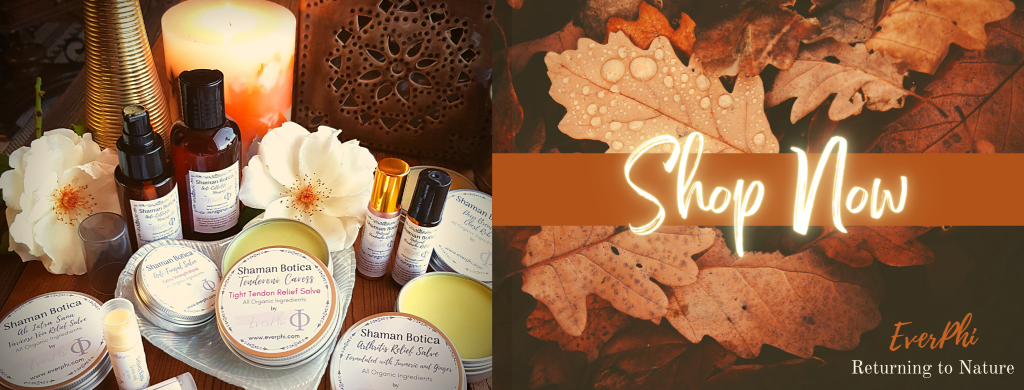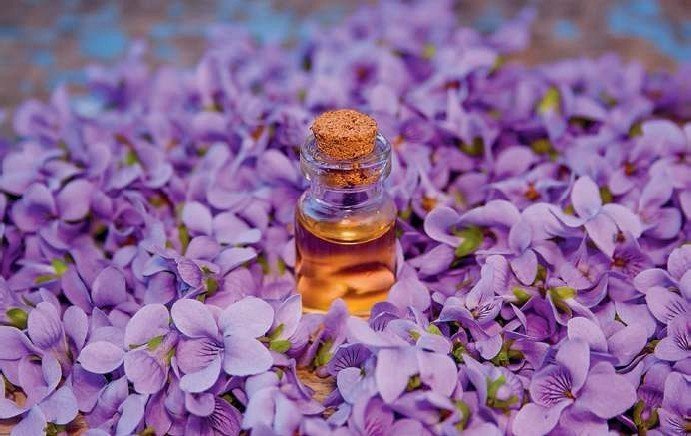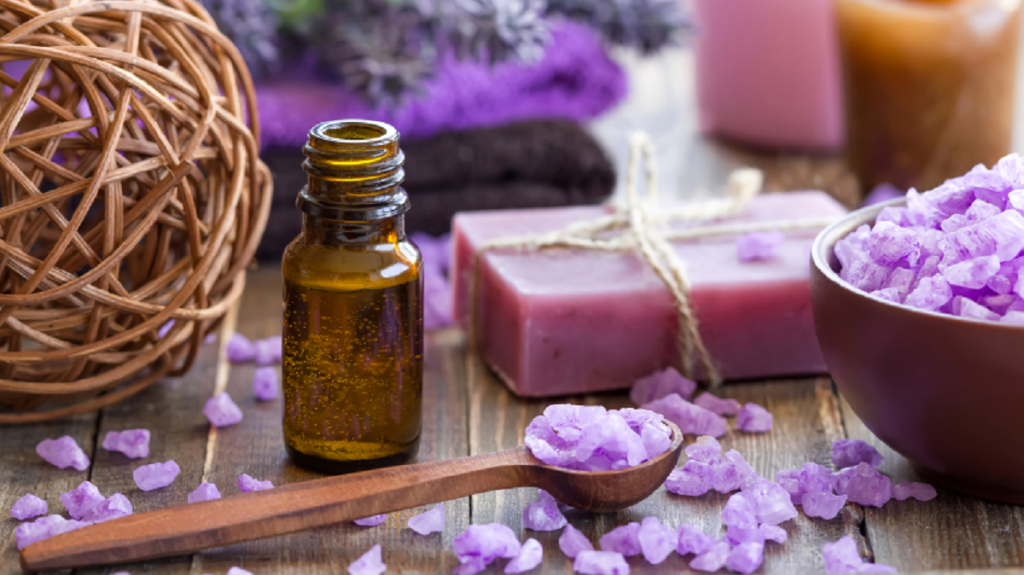
Violet essential oil or violet absolute, is a viscous and greenish brown extract obtained from Viola odorata L. Its pleasant aroma is strong, sweet, leafy and with a tender floral undertone.
Viola odorata oil blends well with a wide spectrum of essential oils and as such is very versatile. Within the floral group you can choose clary sage, lavender, geranium, jasmine, neroli and tuberose oil.
Also, violet absolute combines well with cardamom, ginger, lemongrass, cumin, black pepper, sandalwood, cedarwood, bergamot, orange, mandarin, grapefruit, lime, patchouli, vetiver, basil and coriander essential oil.
The absolute (essential oil) of violet is produced from the leaves and the flowers. The absolute obtained from the leaves is dark green to brown in color, and the one extracted from the purple flowers is yellowish green. The latter is extremely scarce, leaf absolute on the other hand, is more commonly found and is widely used in the perfume industry.
Viola odorata Linn, also known as sweet violet is an evergreen perennial herb belonging to Violaceae family. It is a species of the genus Viola native to Europe and Asia, but has also been introduced to North America and Australasia.
Sweet violet (Viola odorata L.) grows wild in nature, in places exposed to sun, alongside hedges, river banks, on the edges of deciduous forests and in forest glades. It is distributed in Kashmir and western Himalayan regions at an altitude of 1500 to 1800 m asl.
Violet plant grows about 10 cm tall and flowers in late winter. The flowers are nodding, deep violet and sweet scented.
The herb is well known for its therapeutic importance in Ayurvedic and Unani medicine, and is traditionally used as remedy for whooping coughs, common cold, asthma, fever, sore throat, hoarseness and tonsillitis.
In addition, V. odorata is valued as an expectorant, diaphoretic, antipyretic, antibacterial, anti-inflammatory, emollient, diuretic and, as a laxative in bilious affections.
Violet, is used either alone or in mixture with other herbs for catarrhal and pulmonary conditions, as well as for calculous affections.
Other common names for violet include: Sweet violet, Blue violet, March violet, Appel
leaf, Bairn wort, Blaver and English violet.
V. odorata is rich in many phyto-constituents such as saponins, salicylates, alkaloids, flavonoids, tannins, phenolics, coumarins, phenolic glycosides, gaultherin, violutoside, and odoratine.
Analysis of violet essential oil composition revealed the presence of about 100 constituents, with 25 identified compounds representing 92.77% of the oil: Butyl-2-ethylhexyl phthalate (30.10%), and Dihydroactinidiolide (12.03%) being the two main components.
Other key chemical constituents include: Nonadienal, parmone, hexyl alcohol, bezyl alcohol, ionone and viola quercitin.
Violet essential oil, despite being a “floral” and highly aromatic oil, its benefits are not limited only to the cosmetic field, since it has an extensive list of important therapeutic properties that are being reborn thanks to modern aromatherapy.
Among the properties of violet oil are: sedative, analgesic, anti-inflammatory, antioxidant, antibacterial, antifungal, expectorant, decongestant, diaphoretic, febrifuge, anticancer, repellent.
While in an emotional level it has relaxing, balancing, soothing, comforting and inspiring properties.

The multiple common uses of violet oil include:
The whole aerial part of violet plant (including stem, flowers and leaves) are used in cancer treatments. Viola odorata was reported as pharmacological tool and possibly as leads to antitumor agent.
Cycloviolacin O2, a cyclotide from Viola odorata, has antitumor effects and causes cell death by membrane permeabilization.
Recent studies revealed the dominant effects of cyclotides of Viola Odorata as anticancer agents on gastric, intestinal, rectal, breast, uterine, joints, and pharyngeal cancer. It is reported that its conjunction with chemotherapy can increase the survival rate of patients.
The essential oils of Viola odorata in combination with essential oils of other plants have been reported with significant repellant activity against Aedes aegypti, Anopheles stephensi and Culex quinquefasciatus mosquitoes (Amer and Mehlhorn, 2006).
Violet essential oil induced a protection time of 8 hours at the maximum, and in some of the combinations, 100 % activity was observed against all the mosquitoes test species.
The aqueous extract of Viola odorata has been proved as a good remedy for inflammatory lung diseases.
Koocheck et al. (2003), reported the aqueous extract of Viola odorata shown anti-inflammatory properties as compared with hydrocortisone.
Violet extract given prophylactically was partially effective in preventing lung damage, equal to the effect of hydrocortisone in aiding the resolution of formalin-induced lung damage.

The effects and benefits of violet absolute oil on the skin have been published in various studies and literature. Due to its cooling nature, violet oil can be added to any skin formula treatment for skin suffering from redness, inflammation, eczema and dermatitis.
Violet essential oil soothes sensitive, dry, itchy and red skin, and also helps diminish the appearance of thread veins. Besides, it is an excellent moisturizer and emollient agent that gently tighten and refine enlarge pores.
Also, violet oil is good for oily and acne-prone skin as it has antiseptic and anti-inflammatory properties.
In addition, it helps to maintain moisture balance, relax and revitalize the skin when applied in a bath or through massage.
In a 2012 study, the antihypertensive activity of Viola odorata has been reported. The crude extract of the leaves of violet exhibited a potent antihypertensive activity in animal models.
The plant also showed reduction in body weight and antidyslipidemic effect, which may be due to the inhibition of synthesis and absorption of lipids and antioxidant activities.
Dyslipidemia is an abnormal amount of lipids (e.g. triglycerides, cholesterol and/or fat phospholipids) in the blood. In developed countries, most dyslipidemias are hyperlipidemias; that is, an elevation of lipids in the blood. This is often due to dieting and lifestyle.
Thus, this study provides a pharmacologic rationale to the medicinal use of Viola odorata in hypertension and dyslipidemia.
The effect of violet essential oil for fever in children was evaluated in a 2019 study. It showed the safety and efficacy of complementary therapy with violet oil for fever control in febrile neutropenic children during hospital course.
A 2014 study aimed to evaluate the efficacy of violet oil in the treatment of chronic insomnia. It was conducted as a 3-arm double-blind randomized trial.
A total of 75 patients with chronic insomnia were enrolled and randomly assigned to three groups in Traditional Iranian Medicine Clinic of Mashhad University of Medical Sciences, Mashhad, Iran.
The treatment consisted of intranasal dropping of violet oil, Almond oil or placebo (1% solution of Carboxymethyl cellulose) in each nostril every night before sleep for 30 days, i.e. three drops of the drug (including either Violet oil or Almond oil) or the placebo was used every night before the sleep.
All the patients were asked to complete Pittsburgh Sleep Quality Index (PSQI) and Insomnia Severity Index (ISI) questionnaires before and after the intervention.
As a result, when comparing the pre- and post-treatment data, the ISI and PSQI scores improved significantly in all the three groups. The results also showed that violet oil had the most impact among the three groups. In addition, it was more effective on sleep quality than sleep quantity.
Considering the effects of natural nasal drug on the improvement of sleep quality in insomniac patients, this study has proposed the use of violet essential oil as a natural and herbal drug in a non-oral method without serious side effects for treatment of insomnia.

Methanolic and chloroform extract of the leaves of Viola odorata and its essential oils have been tested for their antibacterial potential against various bacteria.
The methanolic extract showed antibacterial activity against P. aeruginosa, E. coli, S. epidermidis and P. vulgaris.
Chloroform fraction, on the other hand showed activity against S. epidermidis and P. vulgaris, while essential oils showed activity against B. subtilis, K. pneumonia and S. epidermidis (Akhbari et al., 2012).
Researches showed that methanol and ethanol extracts of the leaves of V. odorata L. are effective against all tested strains of bacteria, whereas fungi showed resistance to all extracts.
Ethanol extract exhibited higher inhibition against E. coli (10 mg/ml), Bacillus subtilis (20 mg/ml), Staphylococcus aureus (20mg/ml) and Pseudomonas aeruginosa (40mg/ml). Hence, violet oil is used in the treatment of bronchitis, cystitis and tonsillitis, among others.
Dry eye disease is a disorder of the tear film. In a recently 2019 study, the effect of Viola odorata L. oily extract was examined for the treatment of patients suffering from dry eye disease.
A randomised, double-blind, placebo-controlled study was designed. During the trial, Schirmer’s test, tear breakup time, Oxford staining and the Ocular Surface Disease Index were assessed.
Overall, 105 patients with dry eye symptoms between the ages of 18 and 60 years were allocated to the violet-almond oil, almond oil and placebo (1% w/v hydroxypropyl methylcellulose solution) groups.
The treatment and placebo were administered intranasally. Two drops three times a day for one month, and the patients were followed up for four weeks.
A total of 91 patients (32, 29 and 30 in the violet-almond oil, almond oil and placebo groups, respectively) completed the investigation.
At baseline, there was no difference between the three groups in terms of demographic data and the measurement parameters. After the intervention, the results revealed that the Schirmer’s score without local anaesthesia and the tear breakup time results significantly improved in the violet-almond oil group.
One-way ANOVA indicated a significant improvement in the Schirmer’s score, tear breakup time and Ocular Surface Disease Index of the treatment group, as compared with the other groups.
However, the obtained results did not present any significant mean difference between and within the groups of the Oxford staining grade.
As a conclusion, the trial showed that intranasally administered violet oil enhances tear production and improves tear film stability.
Gardenia Essential Oil Uses and Benefits for HealthViolet oil is non-toxic and non-irritating, but may cause sensitization by skin contact in some individuals.
It is advisable perform a patch test before topical application, in order to rule out adverse skin reaction.
Pregnancy and breastfeeding women should consult a qualified aromatherapist before using violet oil, since there is not enough reliable information about its safety in these cases. The same precaution should be taken when used in children.
Violet essential oil has a very strong aroma which is classified as a heart note. Therefore, when used through a diffuser, a single drop is sufficient to achieve a pleasant aromatic experience, while acquiring its therapeutic benefits.

Violet essential oil is a scarce extract in the western market, however, not impossible to find.
As mentioned in the article, violet oil has numerous therapeutic properties, which means that it is an excellent ally to keep in our home treatment kit. However, it is fundamental that when buying, the right product is chosen (with all its therapeutic benefits), and not a synthetic aromatic essence to make candles and/or soaps, for example.
Generally, good quality oils, that is, 100% pure and not mixed with other substances, can be found in specialized natural herb stores.